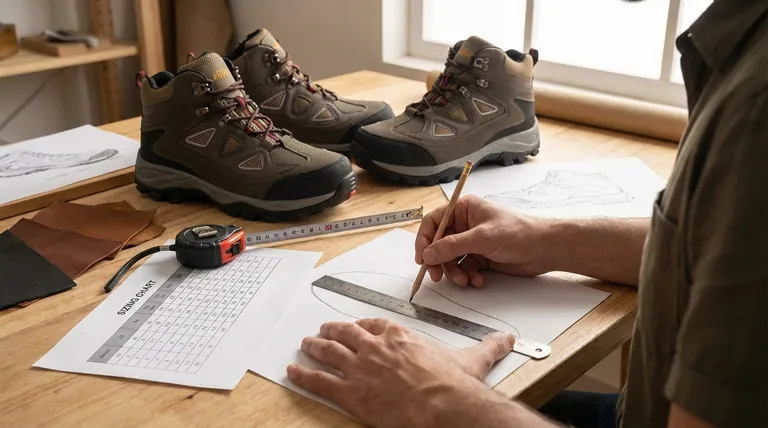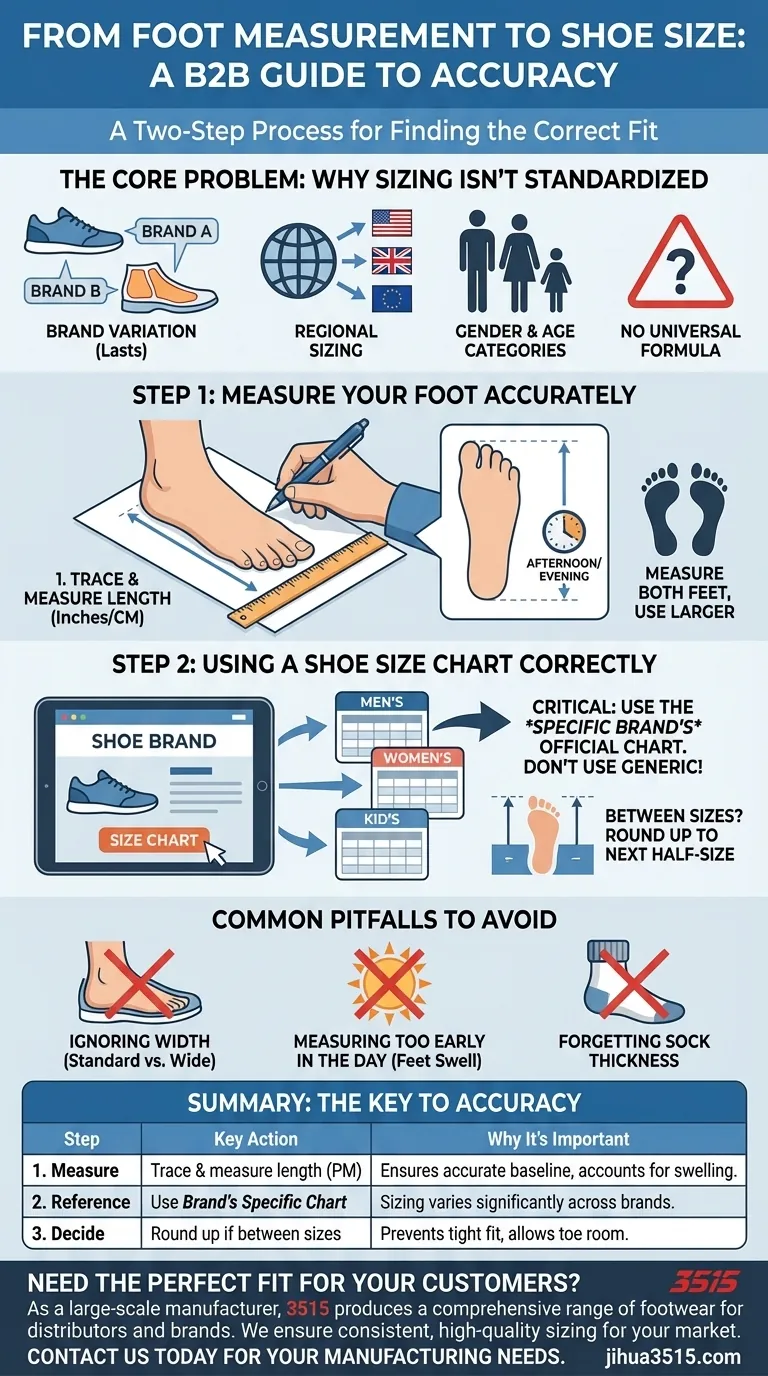To convert your foot measurement to a shoe size, you must first measure your foot's length in inches or centimeters and then cross-reference that measurement on the appropriate size chart. There is no universal mathematical formula because shoe sizing is not standardized; the chart is the essential conversion tool.
The key to finding your correct shoe size isn't a simple conversion formula, but a two-step process: getting an accurate measurement of your foot and then consulting the specific size chart for the brand of shoe you intend to buy.

The Core Problem: Why Shoe Sizing Isn't Standardized
Before measuring, it's crucial to understand why this process is necessary. Shoe sizes are not universally consistent across different brands, regions (US, UK, EU), or even between men's and women's sizing.
Brand-to-Brand Variation
A size 10 from one company can fit differently than a size 10 from another. Each brand uses its own manufacturing molds, called "lasts," which determine the final shape and volume of the shoe.
Regional Sizing Systems
The US, UK, and Europe all use different sizing scales. A US Men's 10 is roughly equivalent to a UK 9 or an EU 43, but these conversions are not always exact.
Gender and Age Categories
Men's, Women's, and Children's shoes are all on different sizing scales. For example, a Men's size 7 is not the same length as a Women's size 7.
Step 1: How to Measure Your Foot Accurately
An incorrect measurement is the most common point of failure. Follow these steps precisely for the most reliable results.
Gather Your Tools
You will need a piece of paper larger than your foot, a pen or pencil, and a ruler or tape measure.
Trace Your Foot Outline
Place the paper on a hard, flat surface. Stand on it with your weight shifted slightly forward to ensure your foot is at its most extended. Trace a snug outline around your entire foot.
Measure the Length
Using your ruler, measure the distance between the two longest points of your tracing—from the back of the heel to the tip of your longest toe.
Account for Both Feet
Most people have one foot that is slightly larger than the other. Measure both feet and use the measurement from the larger foot as your guide.
Step 2: Using a Shoe Size Chart Correctly
Once you have your measurement in inches or centimeters, you can use a chart to find your corresponding size.
Find the Right Chart
First, ensure you are looking at the correct chart for your needs: Men's, Women's, Big Kid's, or Little Kid's.
Always Use the Brand's Specific Chart
This is the most critical step. Navigate to the website of the shoe brand you want to buy and find their official size chart. Do not rely on a generic chart, as it may not reflect that brand's specific sizing.
When You Fall Between Sizes
If your measurement falls between two sizes on the chart, it is almost always best to round up to the next larger half-size. This provides space and prevents pinching.
Common Pitfalls to Avoid
Understanding these common mistakes will help you avoid buying shoes that don't fit, even with an accurate measurement.
Pitfall: Forgetting Foot Width
Standard shoe sizes only account for length. If you have particularly wide or narrow feet, a standard-width shoe (typically "D" for men, "B" for women) may not fit comfortably, even if the length is correct. Many brands offer shoes in different width options.
Pitfall: Measuring at the Wrong Time of Day
Feet naturally swell and expand throughout the day due to activity and gravity. For the most accurate sizing, measure your feet in the late afternoon or evening.
Pitfall: Ignoring Sock Thickness
Consider the type of socks you will wear with the shoes. A thick hiking sock will take up more room than a thin dress sock, potentially requiring you to size up.
Making the Right Choice for Your Goal
Use your measurement to make an informed decision based on your priority.
- If your primary focus is buying shoes online: Always locate and use the official size chart on the product page for the specific brand and model you are considering.
- If your primary focus is the most accurate fit possible: Measure your feet at the end of the day and, if possible, visit a shoe store to have your width professionally measured.
- If your primary focus is avoiding a tight fit: Always round up to the next half-size if your foot measurement lands between two sizes on a chart.
Following this methodical process empowers you to find a comfortable and accurate fit every time.
Summary Table:
| Step | Key Action | Why It's Important |
|---|---|---|
| 1. Measure | Trace and measure your foot's length in the afternoon. | Feet swell during the day; this ensures an accurate baseline. |
| 2. Reference | Use the specific brand's official size chart. | Sizing varies significantly between different shoe brands. |
| 3. Decide | Round up to the next half-size if between sizes. | Prevents a tight fit and allows for comfortable toe room. |
Need the Perfect Fit for Your Customers?
As a large-scale manufacturer, 3515 produces a comprehensive range of footwear for distributors, brand owners, and bulk clients. Our production capabilities encompass all types of shoes and boots, ensuring you get consistent, high-quality sizing for your market.
Let us help you deliver superior comfort and fit. Contact our team today to discuss your manufacturing needs.
Visual Guide

Related Products
- Safety Footwear Wholesale Manufacturer for Custom OEM/ODM Production
- Lightweight Breathable Sneakers with Wet-Traction Grip for Wholesale & Private Label
- Wholesale Lightweight Cushioned Athletic Sneakers for Custom Bulk Production
- Wholesale Safety Footwear Manufacturer for Bulk & Custom OEM Orders
- Premium High-Cut Waterproof Safety Boots Manufacturing & Wholesale Solutions
People Also Ask
- What are OSHA approved shoes? Understanding the Correct Standards for Workplace Safety
- What do heavy duty boots do? Protect Your Feet in Demanding Work Environments
- How do safety shoes contribute to cost savings for companies? A Strategic Investment in Risk and Cost Management
- What are the cultural perspectives on wearing shoes in the house? A Guide to Home Etiquette & Hygiene
- Do snake bite boots work? Your Ultimate Guide to Effective Snake Bite Protection



















